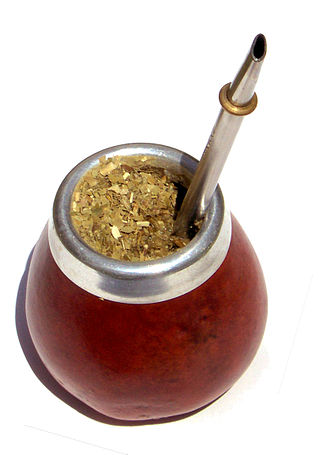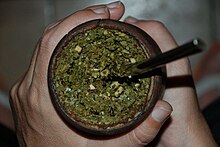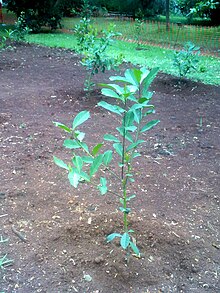
Argentine cuisine is described as a blending of cultures, from the Indigenous peoples of Argentina who focused on ingredients such as humita, potatoes, cassava, peppers, tomatoes, beans, and yerba mate, to Mediterranean influences brought by the Spanish during the colonial period. This led to cultural blending of criollos, Indigenous, and sub-Saharan African in the cuisine. Later, this was complemented by the significant influx of Italian and Spanish immigrants to Argentina during the 19th and 20th centuries, who incorporated plenty of their food customs and dishes such as pizzas, pasta and Spanish tortillas.

Yerba mate or yerba-maté is a plant species of the holly genus Ilex native to South America. It was named by the French botanist Augustin Saint-Hilaire. The leaves of the plant can be steeped in hot water to make a beverage known as mate. Brewed cold, it is used to make tereré. Both the plant and the beverage contain caffeine.

A caffeinated drink, or caffeinated beverage, is a drink that contains caffeine, a stimulant that is legal practically all over the world. Some are naturally caffeinated while others have caffeine added as an ingredient.

A drinking straw is a utensil that is intended to carry the contents of a beverage to one's mouth. Disposable straws are commonly made from plastics. However, environmental concerns related to plastic pollution and new regulation have led to rise in reusable and biodegradable straws. Following a rise in regulation and public concern, some companies have even voluntarily banned or reduced the number of plastic straws used. Alternative straws are often made of reusable materials like silicone or metal or alternative disposable and biodegradable materials like paper, cardboard, pasta, or bamboo.

Tereré is an infusion of yerba mate prepared with cold water, a lot of ice and pohá ñaná, and in a slightly larger vessel. This infusion has its roots in Pre-Columbian America, which established itself as traditional during the time of Governorate of Paraguay. There's also a variant made with juice, called "Juice tereré" or "Russian tereré", depending on the region. On December 17, 2020, UNESCO declared the tereré of Paraguay as an intangible cultural heritage, which includes the drink (tereré) and its preparation methods with medicinal herbs.

The history of tea spreads across multiple cultures over the span of thousands of years. With the tea plant Camellia sinensis native to East Asia and probably originating in the borderlands of southwestern China and northern Myanmar. One of the earliest accounts of tea drinking is dated back to China's Shang dynasty, in which tea was consumed as a medicinal drink. An early credible record of tea drinking dates to the 3rd century AD, in a medical text written by Chinese physician Hua Tuo. It first became known to the western world through Portuguese priests and merchants in China during the early 16th century. Drinking tea became popular in Britain during the 17th century. The British introduced commercial tea production to British India, in order to compete with the Chinese monopoly on tea by stealing green tea leaves from China, transporting them by train/road, resulting in them being fermented and thought fermented tea is the tea drunk in China. Hence the tea drank in the West is mostly fermented and not green fresh tea.

Tea culture is defined by how tea is made and consumed, how people interact with tea, and the aesthetics surrounding tea drinking.

A bombilla (Spanish), bomba (Portuguese) or massasa (Arabic) is a type of drinking straw, used to drink mate. In metal bombillas, the lower end is perforated and acts as a metal filter which is used to separate the mate infusion from leaves, stems, and other mate debris, and functions in a similar fashion to the perforated metal screen of a teapot. Filters can be removable and can be opened for cleaning, or they may be permanently fixed to the bombilla stem. Bombillas vary in length but a popular length is approximately 7 inches (18 cm) long.

Mate or maté is a traditional South American caffeine-rich infused herbal drink. It is also known as chimarrão or cimarrón, and ka’ay in Guarani. It is made by soaking dried yerba mate leaves in hot water and is traditionally served with a metal straw in a container typically made from a calabash gourd, but also made from a cattle horn in some areas. A very similar preparation, known as mate cocido, removes some of the plant material and sometimes comes in tea bags. Today, mate is sold commercially in tea bags and as bottled iced tea.
Swedish Argentines are Argentine citizens of Swedish descent, as well as Swedish-born people who reside in Argentina. The history of Swedish settlement in Argentina took place principally in the mid to late 19th century, when Swedish people arrived in Argentina. Many Swedes came to Argentina for economic reasons and in order to start a new life. Swedes also helped build Argentina, in particular helping to build Argentina's railroads in the mid 19th century.

Tea is a popular drink throughout Turkey and the Turkish diaspora. Turkey has the highest per capita tea consumption in the world with an annual total consumption of over 3 kilograms per person. Turkey is a large exporter of tea, ranking fifth among the top exporting countries. Tea plays a big role in social gatherings that take place in tea houses and gardens. It is also used as a herbal medicine. Turkish tea culture extends to Northern Cyprus and some countries in the Balkan Peninsula. Turkish tea has a long and expansive history that shaped its harvesting even before the founding of the modern Turkish Republic. Since its introduction to Turkey, tea has become a large part of Turkish culture.

Uruguayan cuisine is a fusion of cuisines from several European countries, especially of Mediterranean foods from Spain, Italy, Portugal and France. Other influences on the cuisine resulted from immigration from countries such as Germany and Scotland. Uruguayan gastronomy is a result of immigration, rather than local Amerindian cuisine, because of late-19th and early 20th century immigration waves of, mostly, Italians. Spanish influences are abundant: desserts like churros, flan, ensaimadas yoo (Catalan sweet bread), and alfajores were all brought from Spain. There are also all kinds of stews known as guisos or estofados, arroces, and fabada. All of the guisos and traditional pucheros (stews) are also of Spanish origin. Uruguayan preparations of fish, such as dried salt cod (bacalao), calamari, and octopus, originate from the Basque and Galician regions, and also Portugal. Due to its strong Italian tradition, all of the famous Italian pasta dishes are present in Uruguay including ravioli, lasagne, tortellini, fettuccine, and the traditional gnocchi. Although the pasta can be served with many sauces, there is one special sauce that was created by Uruguayans. Caruso sauce is a pasta sauce made from double cream, meat, onions, ham and mushrooms. It is very popular with sorrentinos and agnolotti. Additionally, there is Germanic influence in Uruguayan cuisine as well, particularly in sweet dishes. The pastries known as bizcochos are Germanic in origin: croissants, known as medialunas, are the most popular of these, and can be found in two varieties: butter- and lard-based. Also German in origin are the Berlinese known as bolas de fraile, and the rolls called piononos. The facturas were re-christened with local names given the difficult German phonology, and usually Uruguayanized by the addition of a dulce de leche filling. Even dishes like chucrut (sauerkraut) have also made it into mainstream Uruguayan dishes.

Matte Leão is a Brazilian infusion and tea brand, now owned by The Coca-Cola Company. The spelling Matte is archaic, but preserved in the trademark; the currently correct Portuguese spelling for the herb and the derived beverage is mate. Matte Leão offers a range of over 100 types of infusions.

Mate cocido, chá mate, kojoi, or yerbiado is an infusion typical of Southern Cone cuisine. It is traditionally prepared by boiling yerba mate in water, then strained and served in cups. It is a bitter tasting beverage, similar to mate but milder, with the same stimulating and nutritional properties. It is also sold in teabags, so it can be prepared like tea.

The history of yerba mate stretches back to pre-Columbian Paraguay. It is marked by a rapid expansion in harvest and consumption in the Spanish South American colonies but also by its difficult domestication process that began in the mid 17th century and again later when production was industrialized around 1900.

Paraguayan cuisine is the set of dishes and culinary techniques of Paraguay. It has a marked influence of the Guaraní people combined with the Spanish cuisine and other marked influences coming from the immigration received by bordering countries such as Italian cuisine and German cuisine. The city of Asunción is the epicenter of the distinctive gastronomy that extends in current Paraguay and its areas of influence, which is the reason why is considered the mother of the gastronomy of the Río de la Plata. It is worth clarifying that in the Paraguayan society, the exchange of knowledge between mestizos, creoles and cario-guaraní people occurred before the Jesuit missions.

Brazilian tea culture has its origins in the infused beverages, or chás, made by the indigenous cultures of the Amazon and the Río de la Plata basins. It has evolved since the Portuguese colonial period to include imported varieties and tea-drinking customs.

Mexican tea culture is known for its traditional herbal teas which are reputed to have medicinal properties. In recent decades, imported tea beverages have also become popular in Mexico. Mexican tea recipes have grown in popularity beyond Mexico as well.
Establecimiento Las Marías is a company specializing in infusions, It develops them all the way from plant to package. It is a source of tea, and its lands are the producers of yerba mate. Taragüi, Unión, La Merced and Mañanita are some of the products that has been relying on over 85 years in the market.

CBSé is an Argentinian brand of yerba mate that has been in the market for more than forty years. It was the first brand to create yerba mate compuesta, which is a mix of yerba mate and herbs. The company produces different types of yerba mate as well as other related products.




















